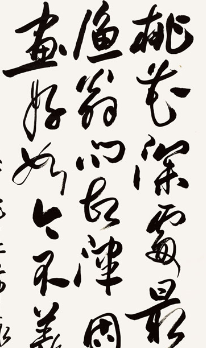画的诗、书、画、印和题跋的结合,兴盛于元代,宋代以前书画家在书画上题跋盖印的,为数极少,元以后便流行开来,题跋和印章便成为鉴定字画的重要辅助依据之一。
The combination of poetry, calligraphy, painting, seal and inscriptions and postscripts of Chinese painting flourished in the Yuan Dynasty. Before the Song Dynasty, few calligraphers and painters used inscriptions and postscripts to seal their paintings and calligraphy. After the Yuan Dynasty, they became popular, and the inscriptions and postscripts and seals became one of the important auxiliary basis for identifying paintings and calligraphy.
(1)题跋,书画的题跋包括作者的题跋(上、下款)、与作者同时代人的题跋和后人的题跋。作者题跋的内容大多数是为了说明这件作品为谁而作,为何而作,同时代人的题跋内容大多为说明这作品的创作过程和赞扬作者的技法等。后人题跋则是考证其真伪和收藏源流等。题跋是书画鉴定中的一个需要注意的地方,作者题跋的不同格式(或曰"署款格式")是书画鉴定的依据之一。
(1) Inscriptions and postscripts of calligraphy and painting include the author's inscriptions and postscripts (upper and lower), those of his contemporaries and those of later generations. Most of the contents of the author's postscripts are to explain for whom and why the work was written. Most of the contents of the postscripts of the contemporaries are to explain the creative process of the work and praise the author's techniques. Posterity's inscriptions and postscripts are to verify the authenticity and the source of collection. Inscriptions and postscripts are important in the identification of calligraphy and painting. The different formats of the author's inscriptions and postscripts (or "the format of payment") are one of the bases for the identification of calligraphy and painting.

(2)印章书画上的印章一般有两类:一类是书画家自己的印章,在作书之后,加钤印章,以表示该书画确为自己所作;另一类是鉴赏或收藏章,收藏者和鉴赏者用此表示自己的鉴定和收藏。印章既然是一种证明物,也就成为书画鉴定中判断作品真伪的辅助依据之一。
(2) There are generally two types of seals on seal painting and Calligraphy: one is the seal of the painter and calligrapher himself, which is sealed after the book is made to show that the painting and calligraphy is really made by himself; the other is the appreciation or collection seal, which is used by collectors and connoisseurs to show their identification and collection. Since the seal is a kind of proof, it has become one of the auxiliary basis for judging the authenticity of works in the identification of calligraphy and painting.
(3)纸絹传统的卷轴书画一般都写画在纸绢上,不同时代的纸绢,有不同的特点,在不同的纸绢上写字作画,便会出现不同的艺术效果。书画家在纸绢的选用上,往往有个人不同的喜好,这些,对书画的鉴定也具有重要的参考作用。如北宋四大书法家苏轼、黄庭坚、米芾、蔡襄都喜欢用熟纸来写字,明代董其昌喜欢用高丽镜面笺纸,其传世的大多数书画精品均用这种纸。清代刘墉、黄易、梁同书常用粉笺纸和蜡笺纸书写。书画家常根据自己的写画习惯和表现技法,选用与之相适应的纸绢,以达到理想的艺术效果。据传世作品来看,唐、五代以前的绘画,几乎全是绢本,宋以后,出现纸本,但范宽、郭熙、马远、夏圭等皆用绢本。元代高克恭、方从义等人的水墨山水画,多用纸本(元代文人山水画,皆用纸本),李衍双钩填色竹则用绢本,明代院体画家亦大都采用绢本。
(3) Paper and silk traditional Chinese scroll painting and calligraphy are generally written on paper and silk. Different times of paper and silk have different characteristics. Writing and painting on different paper and silk will produce different artistic effects. Calligraphers and painters often have different personal preferences in the selection of paper and silk, which also has an important reference role in the identification of calligraphy and painting. For example, Su Shi, Huang Tingjian, Mi Fu and Cai Xiang, the four great calligraphers of the Northern Song Dynasty, all liked to write on cooked paper. Dong Qichang of the Ming Dynasty liked to use Koryo mirror paper, and most of his paintings and calligraphy works were handed down on this paper. In the Qing Dynasty, Liu Yong, Huang Yi and Liang Tongshu used to write on powder paper and wax paper. Calligraphers and painters often choose suitable paper and silk according to their painting habits and performance techniques, so as to achieve the ideal artistic effect. According to Guo Xi's and Ma guikuan's works, they were all handed down from Tang Dynasty to Song Dynasty. In Yuan Dynasty, Gao Kegong, Fang Congyi and others mostly used paper (literati landscape paintings in Yuan Dynasty all used paper), Li Yan used silk for coloring bamboo, and most of the painters in Ming Dynasty also used silk.
古代的纸绢质量有高低之分,书画收藏的状况也有好坏之别,不能光看纸绢的变色和破残程度来断定它的时代远近,还要结合其他方面综合考虑。另外,也有后人用前代流传下来的纸绢作书画的情况。对此,也应注意辨别。
The quality of ancient paper and silk can be divided into high and low, and the collection of calligraphy and painting can also be divided into good and bad. We can't judge the age of paper and silk only by its discoloration and broken degree, but also by considering other aspects. In addition, later generations also used paper and silk handed down from the previous generation for painting and calligraphy. In this regard, we should also pay attention to distinguish.
(4)装潢各时代的书画,其装潢格式及其装潢所用的质料均不同,这对定书画也能起到一定的辅助参考作用。加之前人的收藏印多钤盖于裱件的接缝上,这同装潢的格式也有关系。书画常见的装潢格式有立轴、挂屏、手卷、横披、镜片和册页等。王以坤先生曾在《古书画鉴定法》中列举了画史上颇具名气的宋代"宣和装"的特征,指出宋徽宗赵佶的收藏印在裱件上钤盖的特点。收藏印分有"御书"葫,印、双龙玺印、年号玺和"内府图书之印"等七玺,每一个印章所的部位都有其特点,形成一定的格式,而不少赝品上的伪印,则往往乱盖乱打,毫无规律。
(4) Painting and calligraphy in different times of decoration have different decoration formats and materials, which can also play a certain auxiliary reference role in painting and calligraphy. In addition, the previous collection seal is often covered on the seams of mounting pieces, which is also related to the decoration format. The common decoration formats of calligraphy and painting include vertical axis, hanging screen, scroll, horizontal drape, lens and album. Mr. Wang Yikun once listed the famous characteristics of Xuanhe decoration in the history of painting in the appraisal law of ancient calligraphy and painting, and pointed out that Zhao Ji's collection of song Huizong was stamped on the mounting pieces. There are seven seals in the collection, such as "Yushu seal", "Shuanglong seal", "nianhao seal" and "Neifu Book seal". Each part of the seal has its own characteristics and forms a certain format. However, many fake seals on fakes are often randomly stamped, without any rules.
各时代,各地区的裱工手法技法各有不同,在熟悉了其特点之后,不用打开书画,只需看一下装潢形式,便知其为何时、何地的装裱,乃何家的收藏亦可知。但如做伪者利用旧装潢,换上假画心,这种情况要小心辨别。
The mounting techniques of different times and regions are different. After being familiar with their characteristics, you don't need to open the calligraphy and painting, just look at the decoration form to know when and where it was mounted, and even whose collection. However, if the forgers make use of the old decoration and replace it with a fake painting heart, they should be careful to distinguish this kind of situation.
